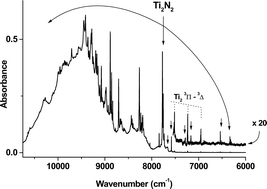Reactivity of titanium dimer and molecular nitrogen in rare gas matrices. Vibrational and electronic spectra and structure of Ti2N2†
Abstract
The reactivity of diatomic titanium with molecular

* Corresponding authors
a Inorganic Chemistry Laboratory, University of Oxford, South Parks Road, Oxford, UK
b Institut für Nanotechnologie, Forschungszentrum Karlsruhe, Postfach 3640, Karlsruhe, Germany
c Institut für Physikalische Chemie, Universität Karlsruhe (TH), Karlsruhe, Germany
d Université Pierre et Marie Curie, CNRS, Laboratoire Dynamique, Interactions et Réactivité UMR 7075, case 49, 4 place Jussieu, Paris, France
The reactivity of diatomic titanium with molecular

 Please wait while we load your content...
Something went wrong. Try again?
Please wait while we load your content...
Something went wrong. Try again?
H. Himmel, O. Hübner, F. A. Bischoff, W. Klopper and L. Manceron, Phys. Chem. Chem. Phys., 2006, 8, 2000 DOI: 10.1039/B517526G
To request permission to reproduce material from this article, please go to the Copyright Clearance Center request page.
If you are an author contributing to an RSC publication, you do not need to request permission provided correct acknowledgement is given.
If you are the author of this article, you do not need to request permission to reproduce figures and diagrams provided correct acknowledgement is given. If you want to reproduce the whole article in a third-party publication (excluding your thesis/dissertation for which permission is not required) please go to the Copyright Clearance Center request page.
Read more about how to correctly acknowledge RSC content.
 Fetching data from CrossRef.
Fetching data from CrossRef.
This may take some time to load.
Loading related content
